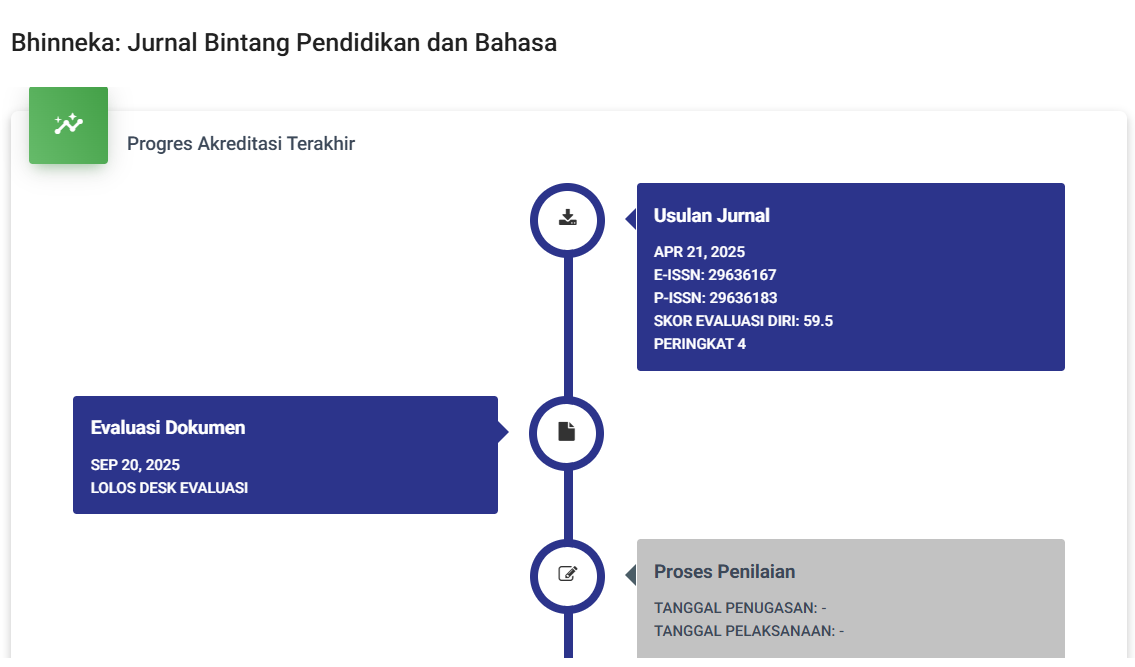Pengaruh Penggunaan Metode Index Card Match terhadap Keaktifan Belajar PAI Siswa SDIT Juara Padang Panjang
DOI:
https://doi.org/10.59024/bhinneka.v2i4.987Keywords:
Index Card Match, Student Learning Activeness, PAIAbstract
The low level of PAI learning activity among students is the driving force for this study. It is believed that the use of learning techniques is inextricably linked to this low activity in PAI learning. Index Card Match is one of the instructional strategies that is thought to have an impact on students' learning activities. to determine if there is a noteworthy impact on Index Card Match use. In order to go toward active learning, the author must carry out experimental study. The Quasy Experiment Design approach was used as the research method in this quantitative study. The location of this study is SDIT Juara Padang Panjang. Class IV A, IV B, and IV C, which were selected at random from 76 students' PTS scores, made up the study's population. Class IV A served as the experimental class and Class IV B as the control class. A questionnaire was one of the research tools utilized in this study (questionnaire). The t-test and F-test were used in the analytical process. The f-test was employed in the experimental class and the t-test in the control class to analyze the data. Based on the data processing results, the study findings indicate that there is a substantial difference in the usage of the Index Card Match technique on students' active PAI learning, supporting the first hypothesis. The fact that tcount (2,560) is higher than ttable (1,677) indicates this. Furthermore, it is evident that there is a considerable impact since the second hypothesis, Fcount, is 96.057 at a significance level of 0.010 <0.05, leading to the rejection of Ho and the acceptance of Ha. Thus, it can be said that using the Index Card Match Method has a big impact on active PAI learning.
References
Aminuddin, & Aprison, W. (2021). Kreativitas guru dan kemampuan mengelola kelas terhadap pendidikan agama Islam. Al-Aulia, 7(2).
Andrianti, I., Sesmiarni, Z., & Armanida. (2017). Implementasi pendekatan scientific pada mata pelajaran pendidikan agama Islam di sekolah dasar. Jurnal Educative, 2(2).
Arif, A. (2002). Pengantar ilmu dan metodologi pendidikan Islam. Ciputat Press.
Arikunto, S. (2013). Prosedur penelitian: Suatu pendekatan praktik. Rineka Cipta.
Budiningsih, A. (2015). Belajar dan pembelajaran. Rineka Cipta.
Departemen Pendidikan Nasional. (2003). Standar kompetensi mata pelajaran pendidikan agama Islam dan MTs. Pusat Kurikulum, Balitbang Depdiknas.
Diedrich, P. B. (2000). Interaksi dan motivasi belajar mengajar. PT Raja Grafindo Persada.
Dimyati. (2018). Upaya meningkatkan keaktifan. FKIP UMP.
Drajat, Z., et al. (2011). Metodik khusus pengajaran agama Islam (5th ed.). Bumi Aksara.
Habiburrahman, S. (2022). Materi pendidikan agama Islam. CV. Feniks Muda Sejahtera.
Hawi, A. (2014). Kompetensi guru pendidikan agama Islam. Rajawali Persada.
Hermawan, A. H. (2007). Belajar dan pembelajaran sekolah dasar. UPI Press.
Jalinus, N., et al. (2021). Riset dan aplikasinya. UNP Press.
Kresnanto, D. (2012). Metode pembelajaran index card match. Rineka Cipta.
Majid, A. (n.d.). Belajar dan pembelajaran pendidikan agama Islam (p. 11).
Majid, A., & Andayani, D. (2006). Pendidikan agama Islam berbasis kompetensi. PT Remaja Rosdakarya.
Mardalis. (2008). Metode penelitian: Suatu pendekatan proposal. Bumi Aksara.
McKeachie, W. J. (2012). Indikator keaktifan belajar. Rajawali Press.
Musianto, L. S. (2002). Perbedaan pendekatan kuantitatif dengan pendekatan kualitatif dalam metode penelitian. Jurnal Manajemen & Kewirausahaan, 4(2).
Nata, A. (1997). Filsafat pendidikan Islam. Logos Wacana Ilmu.
Prasetyo, A. D. (2021). Muhammad Abduh, peningkatan keaktifan belajar melalui model discovery learning di sekolah dasar. Jurnal Basicedu, 5(4).
Pratama, A. (2017). Model simulasi antrian dengan metode Kolmogorov-Smirnov normal pada unit pelayanan. Jurnal Edik Informatika.
Pratama, A. R. (2023). Contextual teaching and learning (CTL) dalam pembelajaran PAI di SDN 02 Percontohan. ALIFBATA: Journal of Basic Education, 3(2), 30-38.
Pratama, A. R. (2023). Implementasi metode brainstorming dalam pembelajaran pendidikan agama Islam di kelas XI SMA Negeri 4 Bukittinggi. Madinah: Jurnal Studi Islam, 10(1), 120-130.
Priyanto, D. (2013). Mandiri belajar SPSS. Yogyakarta.
Purwanto. (2012). Metodologi penelitian kuantitatif untuk psikologi dan pendidikan. Pustaka Belajar.
Raharja, M. (2000). Belajar dan pembelajaran. IKIP Semarang Press.
Rahayu, M. (2023, March 11). Keaktifan belajar siswa.
Ramayulis. (2014). Metodologi pendidikan agama Islam.
Setyosari, P. (2013). Metode penelitian pendidikan dan pengembangan. Prenada Media Group.
Silberman, M. L. (2009). Active learning: 101 cara belajar siswa aktif. Nusamedia.
Siregar, S. (2014). Statistik parametrik untuk penelitian kuantitatif. Remaja Rosdakarya.
Slameto. (2003). Belajar dan faktor-faktor yang mempengaruhinya (p. 54). Rineka Cipta.
Srikandi. (2013). Metodologi penelitian pendidikan: Kompetensi dan praktiknya. Bumi Aksara.
Sudjana, N. (2012). Penilaian hasil proses belajar mengajar. Remaja Rosdakarya.
Sugiono. (2010). Metode penelitian bisnis. Alfabeta.
Sugiyono. (2014). Metode penelitian pendidikan: Pendekatan kuantitatif, kualitatif, dan R&D. Alfabeta.
Sugiyono. (2017). Metode penelitian pendidikan: Pendekatan kuantitatif, kualitatif, dan R&D. Alfabeta.
Downloads
Published
How to Cite
Issue
Section
License
Copyright (c) 2024 Bhinneka: Jurnal Bintang Pendidikan dan Bahasa

This work is licensed under a Creative Commons Attribution-ShareAlike 4.0 International License.








